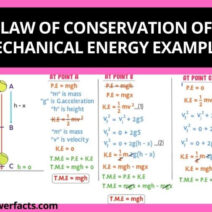In the fascinating realm of physics, the law of conservation of energy stands as a fundamental principle, illustrating the inexorable connection between various forms of energy. This principle espouses that energy cannot be created or destroyed; it can only transform from one type to another. Among the many applications of this vital doctrine, the determination of maximum height using conservation of energy presents a compelling intersection of theoretical physics and practical problem-solving. It provides an elegant approach to understanding motion, particularly in the context of gravitational forces.
At the heart of this inquiry lies the interplay between kinetic energy (the energy of motion) and potential energy (the stored energy of position). When an object ascends against gravitational pull, it expends kinetic energy to overcome the force of gravity, thereby converting it into gravitational potential energy. Conversely, as the object descends, potential energy is transformed back into kinetic energy. This seamless interchange is not merely a phenomenon confined to the classroom; it echoes throughout the natural world, the most spectacular examples being seen in the flight of birds, roller coasters, and the motion of pendulums.
To elucidate the relationship between maximum height and energy conservation, let us consider a simplified model. Imagine a projectile launched vertically with an initial velocity (v) from the ground level. The kinetic energy (KE) of the object as it leaves the launcher is given by:
KE = frac{1}{2}mv^2
where (m) represents the mass of the projectile. As the projectile ascends, it loses kinetic energy while simultaneously gaining gravitational potential energy (PE). The potential energy at a height (h) can be expressed as:
PE = mgh
In this equation, (g) denotes the acceleration due to gravity, approximately (9.81 , text{m/s}^2) near Earth’s surface. For the projectile to reach its maximum height, the kinetic energy will be completely converted into potential energy. At this juncture, the projectile momentarily halts; consequently, its velocity and, thus, its kinetic energy becomes zero:
KE_initial = PE_max
Substituting the equations yields:
frac{1}{2}mv^2 = mgh
Notably, the mass (m) cancels out from both sides, simplifying the equation:
frac{1}{2}v^2 = gh
From this, one can solve for the maximum height (h):
h = frac{v^2}{2g}
This elegant formula illustrates how the maximum height of an object depends proportionally on the square of its initial velocity and inversely on the gravitational acceleration. What this means in practical terms is that as one increases the launch velocity, the potential energy—and hence the maximum height—soars as well, all while the profound principle of energy conservation remains intact.
One may wonder: what influences initial velocity? Several practical factors come into play, such as the method of launch, the angle of release, and the energy input at the initiation. An object’s interaction with its surrounding environment, including air resistance, also merits consideration. In real-world applications, while this model serves as a robust approximation, factors like drag force can impede the accuracy of the predicted maximum height. Nevertheless, even a rudimentary understanding of these interactions offers invaluable insight into the complexities of energy transfer in dynamic systems.
To deepen our appreciation for this concept, let us explore some fascinating analytical applications of the conservation of energy. For instance, in fields like astrophysics, this principle plays a critical role in understanding the trajectories of celestial bodies. The precise calculation of heights in experimental or engineering contexts—such as when launching satellites or constructing amusement park rides—necessitates a firm grasp of these foundational principles.
Moreover, the law of conservation of energy resonates with broader existential themes. It elegantly encapsulates not merely the movement of objects, but profound cycles inherent in life and the universe. The transformation of energy, whether from food to muscle movement in creatures or the conversion of solar energy into chemical energy through photosynthesis, reflects an omnipresent eloquence that pervades our natural existence. Such observations prompt a deeper inquiry into our relationship with energy, urging consideration of sustainable practices as humanity grapples with climate challenges.
In summary, the calculation of maximum height through the lens of the conservation of energy is an explication steeped in scientific elegance. Understanding this relationship provides not merely academic insight but amplifies a much larger narrative concerning the interconnection of energy in various forms. As practitioners of physics or enthusiasts alike explore this fascinating concept, they grasp not just the mechanics of motion but also the philosophical musings behind energy’s intricate dance throughout our world. This nuanced understanding paves the way for future innovations that may further harmonize human activity with the cosmic dance of energy conservation, reminding us of the delicate balance we must uphold in our quest for progress.





